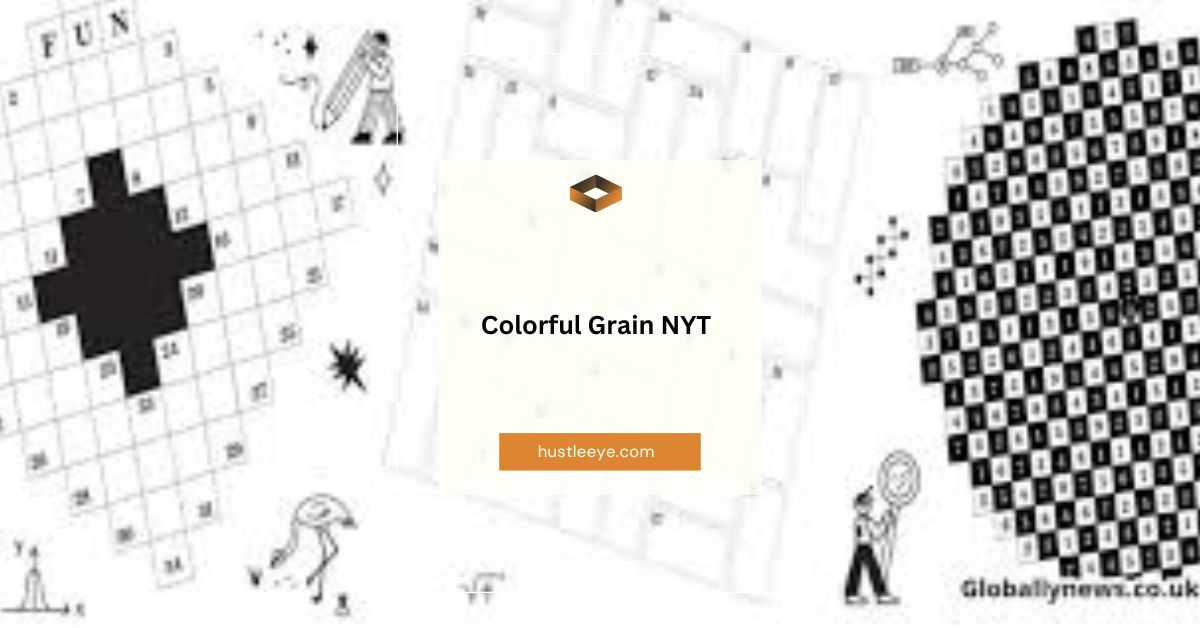Crossword puzzles have captivated minds for generations, offering not just a pastime but a cerebral workout that enhances vocabulary, problem-solving skills, and even patience. For many, The New York Times (NYT) crossword is the gold standard of puzzle craftsmanship, delivering both simple and mind-bending challenges through clever wordplay, cryptic clues, and satisfying answers. A recent clue that has piqued the curiosity of solvers is “Colorful Grain NYT,” sparking debates and speculation about its meaning. This article will explore this intriguing clue and its solution, alongside a broader discussion on crossword puzzles and how they reflect our culture, language, and knowledge.
Table of Contents
Introduction to NYT Crossword Puzzles:
Crossword puzzles have been a mainstay of newspapers for over a century, combining wit, knowledge, and lateral thinking to create a challenge that can entertain and educate simultaneously. Among the most renowned crossword puzzles is The New York Times Crossword, which began in 1942 and has since become the epitome of puzzle design and sophistication.
NYT puzzles are known for their clever, often multi-layered clues. Some days the puzzles are relatively easy, such as on Mondays, but by Saturday, the difficulty can increase dramatically. The Sunday puzzle is the largest and most revered, often with a fun theme or twist.
Solvers have to rely on their vocabulary, cultural knowledge, and sometimes even a dash of trivia. This mix of challenge and creativity makes NYT crosswords so appealing to solvers worldwide.
Read More: Obituary for Allie Eneix Warren, Minnesota: A Life of Dedication and Service
Understanding the Clue: Colorful Grain NYT:
The clue “Colorful Grain NYT” is a perfect example of the elegance of NYT crossword clues. At first glance, the words “Colorful” and “Grain” might seem straightforward, but solvers are quickly thrown off if they only think of common grains like rice, wheat, or oats. The term “colorful” invites us to think beyond the mundane and to consider something visually striking.
By considering different grains that come in various colors, such as red quinoa, black barley, and multicolored corn, one could think of several possible answers. However, none of these seem to fit in the specific crossword where the clue appeared.
Upon closer inspection, Purple Rice emerges as the correct answer to this clue. While lesser-known than its white and brown counterparts, purple rice stands out due to its vibrant hue and rich nutritional content, making it the solution to the mysterious “Colorful Grain NYT.”
Read More: Understanding Alco Gravure Printing Midland: A Comprehensive Guide to Quality Printing Solutions
The Role of Food in Crossword Clues:
Food is a frequent and familiar theme in crossword puzzles, as it is a universal part of human experience. Crossword constructors often use food-related terms because they are familiar to most solvers and can have multiple layers of meaning. A term like “grain,” for instance, might refer to a specific type of cereal crop (like rice, wheat, or quinoa), but it could also be interpreted in broader ways, such as a texture or even something metaphorical.
For “Colorful Grain NYT,” the food element serves as both the literal and figurative key to unlocking the puzzle. Many crossword clues lead solvers down paths of synonyms, homonyms, or even cultural references, but in this case, the vibrant color of purple rice points directly to a solution based on appearance and culinary knowledge.
Read More: How Did Quentin Conway Pass Away? A Heartfelt Tribute and In-Depth Exploration
Exploring Grains: A Look Beyond Rice
To understand why Purple Rice was the solution to “Colorful Grain NYT,” it’s important to explore the diversity of grains. While many of us are familiar with common grains like white rice, brown rice, and oats, there are many colorful grains that add variety to both our diets and crossword puzzles. Let’s look at some of the colorful grains that could potentially fit crossword clues:
- Black Rice: Also known as “forbidden rice,” black rice has a deep, almost inky hue and is packed with antioxidants.
- Red Quinoa: A variation of quinoa, this grain is often used in salads and side dishes for its earthy flavor and striking color.
- Multicolored Corn: In various parts of the world, corn comes in an array of colors including blue, red, and purple.
- Farro: While not typically colorful, farro is an ancient grain that has gained popularity for its nutty flavor and chewy texture.
Each of these grains reflects a different aspect of human history and cuisine, but for the specific crossword clue in question, purple rice stands out as the clear answer.
Unveiling the Answer: Purple Rice
The answer to the “Colorful Grain NYT” crossword clue is Purple Rice, a grain that not only stands out for its appearance but also for its nutritional profile. Known for its striking purple hue, purple rice is often used in Asian cuisines, particularly in Thailand, China, and Korea. The color of purple rice comes from anthocyanins, the same pigments found in blueberries and other purple foods.
1. Why Purple Rice?
Purple rice is a unique grain that fits perfectly into the clue. It is not only colorful, as the clue suggests, but also a type of grain, which is essential for solving this particular puzzle. The New York Times crossword often rewards solvers who think beyond the obvious and explore less common knowledge areas. By knowing about lesser-known grains like purple rice, solvers can tackle even the most challenging puzzles.
Read More: How to Get Glass Skin as a Man thebeautyblizz.com: A Comprehensive Guide
The Nutritional and Cultural Significance of Purple Rice:
Purple rice isn’t just visually appealing; it’s also loaded with nutrients. Rich in fiber, iron, and antioxidants, purple rice is often regarded as a “superfood.” It has been cultivated for centuries in parts of Asia and was historically reserved for royalty, which is why it is sometimes called “forbidden rice.”
In modern times, purple rice is celebrated for its health benefits and is often used in gourmet dishes. Its unique flavor and chewy texture make it a favorite among food enthusiasts, while its striking color adds an aesthetic appeal to dishes.
The crossword clue, Colorful Grain NYT, cleverly connects solvers to a fascinating grain that has both culinary and historical significance.
Strategies for Solving NYT Crossword Puzzles:
For those who regularly engage with the New York Times crossword, solving strategies can make a big difference. The clue “Colorful Grain NYT” might seem daunting at first, but with the right approach, solvers can crack it. Here are a few tips for tackling tricky clues like this:
1. Break Down the Clue:
Start by analyzing the clue word by word. In this case, “Colorful” leads you to think of vibrant hues, while “Grain” narrows it down to specific food items.
2. Think Beyond the Obvious:
As with the “Colorful Grain NYT” clue, crossword constructors often expect solvers to look past the immediate answer. White or brown rice may come to mind first, but considering more exotic grains helps narrow the options.
3. Use Cross References:
In the puzzle, surrounding clues can help confirm your answer. If you’re unsure about a certain word, check to see if your guess fits with nearby across and down clues.
4. Keep Learning:
The more you know, the better you’ll be at solving crosswords. Reading about foods, historical events, and even pop culture can give you an edge.
Read More: Mykhailo Farmiga: A Deep Dive into His Career and Legacy
The Role of Wordplay in Crosswords:
Crossword puzzles often involve more than just straightforward definitions. They include wordplay, puns, and double meanings that challenge solvers to think in new ways. The Colorful Grain NYT clue is an example of this, as it uses the word “colorful” not in the metaphorical sense (like colorful language or characters) but literally, referring to a vibrant hue found in food.
1. Types of Wordplay in Crossword Puzzles:
- Anagrams: Rearranging letters to form a word.
- Puns: Using words with double meanings.
- Homophones: Words that sound the same but have different meanings.
- Cryptic Clues: Particularly tricky clues that require breaking down the meaning behind the words.
Crossword Puzzles in Popular Culture:
Crossword puzzles, particularly the New York Times crossword, have gained a significant cultural presence over the years. They appear in movies, TV shows, and even in music. They have become symbols of intellectual challenge and entertainment. For many, solving the daily crossword is a ritual, whether in the newspaper or on the NYT Crossword app.
The Growing Popularity of The NYT Crossword:
The popularity of the NYT Crossword has only grown in recent years, thanks to its digital expansion. With apps and online platforms making it easier than ever to access puzzles, new solvers are joining the ranks every day. The daily puzzle continues to offer mental stimulation while introducing solvers to new words, concepts, and cultural references.
Read More: Firuñais: A Cultural Symbol of Affection and Companionship
The Appeal of “Colorful Grain NYT” and Similar Clues:
Clues like “Colorful Grain NYT” appeal to solvers because they are both simple and complex at the same time. On the surface, the clue appears straightforward, but it requires a deeper level of thinking to uncover the correct answer. This balance of challenge and satisfaction is what makes the NYT crossword so beloved.
1. Why Are Such Clues So Popular?
- Educational Value: Solvers learn new words or phrases.
- Challenge: They require lateral thinking and creativity.
- Satisfaction: Successfully solving a tough clue gives a sense of achievement.
Read More: IconFashionista: The Evolution of a Modern Fashion Leader (2024)
FAQs About Crossword Puzzles and the Colorful Grain NYT Clue:
1. What is the answer to the “Colorful Grain NYT” clue?
The answer is Purple Rice, a grain known for its vibrant purple color and health benefits.
2. Why does the New York Times crossword use food-related clues?
Food is a universal topic that most solvers can relate to, making it a common theme in crossword puzzles.
3. What are some tips for solving tricky crossword clues?
Break down the clue, think beyond the obvious, use cross-references, and keep learning about different topics to enhance your solving skills.
4. What makes the NYT crossword so popular?
The NYT crossword is revered for its clever clues, varying difficulty levels, and its ability to both entertain and educate solvers.
5. Are crossword puzzles good for brain health?
Yes, studies have shown that solving crossword puzzles regularly can improve memory, cognitive function, and problem-solving skills.

